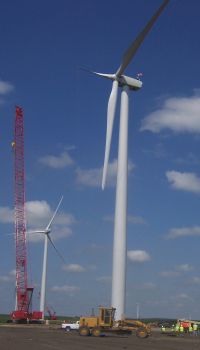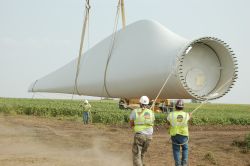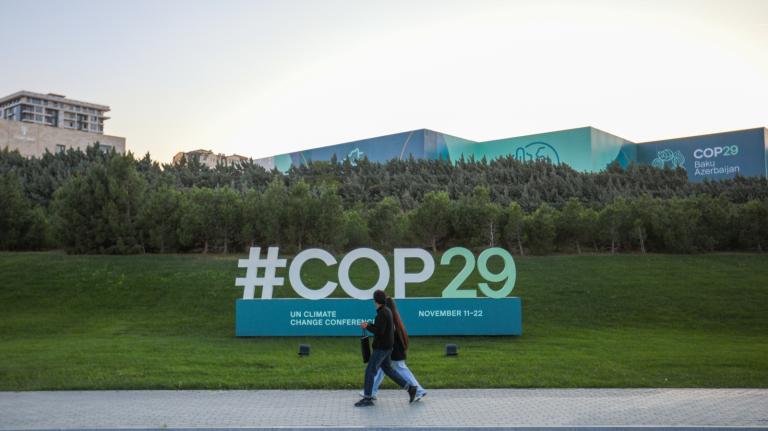Dear Kevin,
 I’ve heard lots of hype about wind power jobs, but I don’t know what kind of jobs we’re talking about. Can you describe a few? Thanks for your help. (I love Grist.)
I’ve heard lots of hype about wind power jobs, but I don’t know what kind of jobs we’re talking about. Can you describe a few? Thanks for your help. (I love Grist.)
Amy K.
St. Louis
Dear Amy,
Grist loves you back. Your letter goes straight to the top.
The hype is very real. Reliable correspondents from the American Wind Energy Association’s massive June conference in Texas report that everyone was talking about a shortage of trained and experienced people. I believe that “we need people yesterday” was the exact phrase. So while “the answer” may not be blowing in the wind, a zephyr of new jobs is sweeping down the plains. Turbines are sprouting like wildflowers after rain in Texas, California, Iowa, Minnesota, Washington, Oregon, Colorado, Illinois, and Oklahoma. Not to mention China.
Now that Texas oil billionaire T. Boone Pickens has morphed into Texas wind billionaire T. Boone Pickens, growth is likely to pick up even more.
Current job total and growth potential
As the hype about “green” jobs has grown, the wind-energy industry has done a pretty good job of reporting accurately on their job creation. Industry analysts estimate that wind energy currently employs about 50,000 domestic workers, both on-site at wind farms and down the chain of products and services needed to build, transport, install, and operate all those turbines.
The number of jobs is growing quickly, however, and wind companies could support as many as 500,000 jobs 20 years from now. That’s according to a Department of Energy report that outlines a plan for the nation to get 20 percent of our electricity from wind power by 2030.
Think 20 percent by 2030 sounds far-fetched? The World Wind Power Association says that wind already provides 19 percent of electricity production in Denmark, 9 percent in Spain and Portugal, and 6 percent in Germany and Ireland. And they’re not just blowing … oh, never mind.
Wind energy technicians
The fastest growing job title in the wind-energy world might just be wind technician. Community colleges across windy states are gearing up to train big incoming classes. Programs can be found at Iowa Lakes Community College, Laramie County Community College in Wyoming, Highland Community College in Illinois, Columbia Gorge Community College in Washington, and Mesalands Community College in New Mexico. This last program won instant fame when GE agreed to hire all of its graduates — for the next three years.
Technicians perform a wide variety of tasks in the construction, operation, and maintenance of wind turbines. Requirements include a year of mechanical experience and a basic understanding of hydraulics and electrical systems. The job also requires comfort with heights and confined spaces because that’s where you’ll spend a lot of your time. And you must be willing to travel — it won’t be unusual to be on the road six weeks at a time.
Several hiring authorities told me that technician positions are great career development starting places for people eyeing this industry. After some experience in the field, technicians can veer off in several directions — some toward further education in technical/engineering fields, and others toward sales, marketing, management, finance, and regulation professions.
Manufacturing
Installation of wind farms throughout the country is ramping up on a steep slope, and that means the need for more domestic manufacturing is expanding. Currently, there are more than 100 turbine or turbine-component manufacturers operating in the U.S. Many of these facilities are owned by the foreign companies that dominate the industry. Of the top 12 global manufacturing companies, only two (GE Energy and Clipper Windpower) are U.S. owned. The rest are from Denmark, Spain, Germany, China, Japan, and India.
Welders who know their way around arc and gas welding equipment and who have “fit up” welding ability are in serious demand at manufacturing facilities. It’s a plus if you can offer header and heat exchanger experience. (Don’t know what any of that means? Don’t have any friends who know what that means? Now you understand why there’s a shortage of talent.)
Component manufacturers want machining operators with three to five years of experience. Being competitive for these jobs requires knowledge and proficiency with leading measurement software programs like PC-DMIS or those from MeasureMax. You’ll also need skill in gauge calibration, ability to read and interpret blueprints and engineering drawings, good math skills, and experience with the “production part approval process.”
Of course, manufacturing companies also need plenty of steelworkers, trades people, design and process engineers, and a full complement of people in sales, marketing, human resources, finance and accounting, general management, and environment/health/safety.
Finding and developing wind power sites
You don’t need a weatherman to know which way the wind blows — just a wind resource assessment specialist. These professionals develop and use complex climatological computer models to assess sites for wind-power potential. The most senior resource assessment analysts need master’s degrees (and sometimes doctorates) in fields like meteorology, climatology, atmospheric science, statistics, mathematics, and engineering.
Wind project technical development managers perform some of the same duties, but often one or two steps closer to individual project sites. They may manage the wind-energy resource assessment process, which determines viability prior to construction and forecasts wind resources after commissioning. These techies assist with wind-farm layout and help assess environmental impacts, electromagnetic interference, interconnection issues, and estimates for energy yield.
Think you’ve found a decent place to put up those turbines? Time to bring on the project development manager, who moves a project from site identification through financial closing and start of construction. Technical ability is important, but people skills and political savvy are essential. This is the manager who builds effective relationships with elected officials, regulators, and community representatives; navigates the environmental study and permitting process; oversees the financial analysis and modeling; sees to the acquisition of land rights; and generally handles negotiations.
Developing a successful wind farm means linking up to a transmission grid — and jobs for transmission design engineers. These engineers need skills and experience in developing and reviewing high-voltage interconnection configurations and designs that include transmission lines, substations, and connection systems. You’ll also need to be good with people: It’s your job to negotiate with “interconnecting transmission entities” to reach design configurations that work for everyone. If you’re looking for job security, this is a great place to do it. Experienced professionals with these skills will soon be retiring in droves, and you’ll be there to take their job.
About those “interconnecting transmission entitites”? At least one of them is likely to be a utility company represented by a utility wind-program manager. No matter where you are in the nation, it’s likely your utility has one. This is the person who monitors the operation, technical challenges, performance, and organizational structure for a utility’s wind generation. The job involves tracking and analyzing generation data, identifying trends for planning and compliance verification, preparing regulatory data requests, and compiling performance data.
Construction
Turning a patch of prairie, part of a soybean farm, a long ridgeline, or part of the ocean into a wind-power facility is a big, specialized construction job. The massive towers that hold the equally huge propellers run 200-300 feet high (or more), and they need to be rock steady when the turbines are cookin’ in a strong wind.
Every wind-energy construction project requires electrical engineers, from initial conception and preconstruction through project close. There is a huge demand for people with electrical engineering degrees or (at least) some combination of training and experience. Firms are seeking people with electrical construction or electrical design experience and knowledge of National Electrical Code. (As an aside, utility companies, solar companies, energy-efficiency companies, and others are also seeking electrical engineers. Seems 2008 is a very good time to be an EE.)
To be sure that all is well before construction starts, pre-construction managers prepare construction plans and schedules, evaluate site conditions, coordinate detailed site investigation and engineering studies, and review “interconnection” requirements for linking to the transmission grid. Landing one of these jobs will take a degree in construction management or engineering, as well as knowledge of the permitting and licensing requirements for electrical facilities.
Who will you find working the actual construction sites? Laborers will be pouring the concrete pads that hold the towers in place, among other activities. Skilled crane operators will be driving piles, placing concrete with crane buckets, hoisting both materials and people, and conducting regular safety inspections. You’ll find Spiderman-like turbine installers setting up rigging cables and installing torquing bolts inside the towers.
Finally, these crews are led by construction managers, who are in serious demand. It’ll be your job to manage, well, everything, and that means being present 100 percent of the time while construction is going on. Among other things, you’ll ensure that all of the contractors comply with standards, the schedule, and quality-control requirements.
Recruiters and in-house HR departments tell me that the travel requirements of these jobs can be a real killer, and it’s one of the main problems in finding and retaining good people. It’s not unusual for some of the engineers and managers to travel as much as eight months of the year — usually to remote destinations for long periods of time.
 Transportation
Transportation
I was surprised to learn that transportation expenses are a big part of the cost of installing a wind farm. Two weeks ago, however, I was on the highway just east of Portland, Ore., and I saw just how big a truck needs to be to carry one wind turbine propeller blade to a wind farm site.
It takes a lot of runs to get these huge pieces of metal to their destination. That’s why there is a growing demand for large-load transportation specialists who can cart towers and propellers around the countryside without taking out a Prius two lanes over.
Finding wind energy jobs
You can find jobs like these all over the country at AWEA’s careers site. It has a good list of currently available (and well described) jobs and links to companies and a host of other resources.

